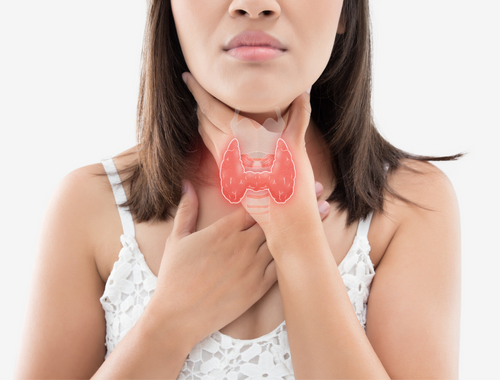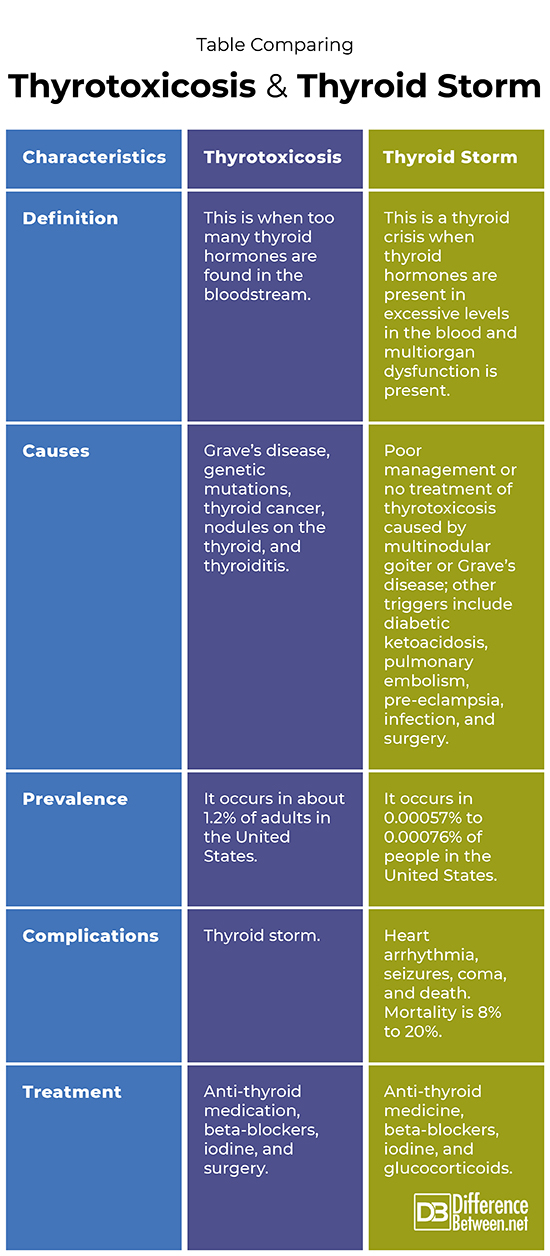Difference Between Thyrotoxicosis and Thyroid Storm
Thyrotoxicosis is abnormal concentrations of thyroid hormones. A thyroid storm is abnormal thyroid hormones leading to multiorgan dysfunction.

What is Thyrotoxicosis?
Definition:
Thyrotoxicosis is when there are higher than normal levels of thyroid hormones in the blood. Thyrotoxicosis is also sometimes referred to as hyperthyroidism.
Causes and prevalence:
The causes of thyrotoxicosis include goiter, Grave’s disease, and inflammation of the thyroid (thyroiditis). Of these, the most common reason for having thyrotoxicosis is Grave’s disease. Toxic adenoma and multinodular goiter are also common reasons why you may have hyperthyroidism. Thyroid cancer, genetic mutations of thyroid-stimulating receptor genes, and chemotherapy can sometimes trigger thyrotoxicosis. Thyrotoxicosis occurs in about 1.2% of individuals.
Symptoms and complications:
Symptoms of thyrotoxicosis include nervousness, weight loss, diarrhea, insomnia, and hyperactivity. People with thyrotoxicosis may also be sensitive to heat, have tachycardia, a warm skin, and experience fibrillation of the heart’s upper chambers (the atria).
Diagnosis:
Blood tests can be done to diagnose thyrotoxicosis. These tests will show elevated levels of the thyroid hormones triiodothyronine (T3) or thyroxine (T4), or both.
Treatment:
Propylthiouracil is an anti-thyroid medicine that is used often along with iodine to treat thyrotoxicosis. Beta-blockers are also sometimes used. Surgery is done for patients with nodules in the thyroid.

What is a Thyroid storm?
Definition:
A thyroid storm is also known as a thyroid crisis and is when there are both unusual thyroid hormone levels in the blood and also multiorgan dysfunction.
Causes and prevalence:
Thyroid storm occurs in cases of multinodular goiter or Grave’s disease where no treatment has been given. It is most often a complication of thyrotoxicosis due to Grave’s disease. Other factors can also activate the thyroid crisis condition. For instance, pulmonary embolism, diabetic ketoacidosis, pre-eclampsia, a traumatic event, or infection can trigger thyroid storm. A thyroid storm is much rarer than thyrotoxicosis and is a complication of this condition.
Symptoms and complications:
Symptoms of thyroid storm include a high fever, sweating, rapid heart rate, pulmonary congestion, heart arrhythmias, delirium, psychosis, liver congestion, and jaundice. Complications include heart failure, coma, seizures, and death.
Diagnosis:
Diagnosis is based on thyroid function tests showing high levels of T3 and T4 hormones but low levels of TSH hormone, the presence of symptoms; other indications of the condition include high blood glucose and high blood calcium levels. There is also a Burch-Wartofsky Point Scale (BWPS) that can be used, which scores symptoms related to the nervous system, heart, digestive system, and body temperature. Where the score is 45 and higher, the diagnosis of thyroid storm is likely.
Treatment:
Medications such as propylthiouracil to block and reduce the levels of thyroid hormones is used, and iodine is given. A beta-blocker and glucocorticoids are typically also used.
Difference between Thyrotoxicosis and Thyroid storm?
Definition
Thyrotoxicosis is when there are elevated hormones (T3 and T4) in the bloodstream. A thyroid storm is when there is a crisis and when hormone levels are in excess and many organs are malfunctioning.
Causes
Causes of thyrotoxicosis include Grave’s disease, genetic mutations, thyroid cancer, nodules on the thyroid, and thyroiditis. Causes of thyroid storm include no treatment or unsuccessful treatment of thyrotoxicosis caused by multinodular goiter or Grave’s disease; other triggers include diabetic ketoacidosis, pulmonary embolism, pre-eclampsia, infection, and surgery.
Prevalence
Thyrotoxicosis occurs in about 1.2% of adults in the United States. A thyroid storm occurs in 0.00057% to 0.00076% of people.
Complications
The complications of thyrotoxicosis include a thyroid storm. The complications of a thyroid storm include heart failure, seizure, coma, and death.
Treatment
Treatment options for thyrotoxicosis include anti-thyroid medication, beta-blockers, iodine, and surgery. Anti-thyroid medicine, beta-blockers, iodine, and glucocorticoids are used to treat thyroid storm.
Table comparing Thyrotoxicosis and Thyroid storm

Summary of Thyrotoxicosis Vs. Thyroid storm
- Thyrotoxicosis and thyroid storm both occur when hormones produced by the thyroid are at too high a concentration in the blood.
- Thyroid storm is when thyrotoxicosis becomes severe resulting in a dangerous condition.
- Treatment of thyrotoxicosis and thyroid storm are similar.
FAQ
What are the three types of thyrotoxicosis?
The three most common types of thyrotoxicosis are toxic adenoma, multinodular goiter, and Grave’s disease.
What are the typical signs noted with thyrotoxicosis or thyroid storms?
Some typical signs include increased heart rate and atrial fibrillation. People may also lose weight and have stomach problems.
What is the difference between Grave’s disease and thyrotoxicosis?
Grave’s disease includes more than thyrotoxicosis. Other signs of Grave’s disease are exophthalmos (projecting eyeballs), and pretibial myxedema (lesions on the skin). Thyrotoxicosis refers to the symptoms such as anorexia, nervousness, and weight loss.
What are the signs of thyrotoxicosis?
The signs of thyrotoxicosis include a rapid heart rate feeling nervous, weight loss, diarrhea, anorexia, insomnia, and hyperactivity.
What triggers a thyroid storm?
Many factors can trigger a thyroid storm including untreated Grave’s disease, multinodular goiter, diabetic ketoacidosis, pulmonary embolism, pre-eclampsia, infection, and surgery.
Can hyperthyroidism cause thyroid storm?
Yes, hyperthyroidism that is not treated can worsen, causing a thyroid storm to occur. This is a dangerous situation because a thyroid storm can be deadly.
- Difference Between Rumination and Regurgitation - June 13, 2024
- Difference Between Pyelectasis and Hydronephrosis - June 4, 2024
- Difference Between Cellulitis and Erysipelas - June 1, 2024
Search DifferenceBetween.net :
Leave a Response
References :
[0]Braunstein, Glenn D. “Hyperthyroidism (Thyrotoxicosis)”. Merckmanuals. Merck & Co., 2022, https://www.msdmanuals.com/professional/endocrine-and-metabolic-disorders/thyroid-disorders/hyperthyroidism
[1]Carroll, Richard, and Glenn Matfin. "Endocrine and metabolic emergencies: thyroid storm." Therapeutic advances in endocrinology and metabolism 1.3 (2010): 139-145.
[2]Pokhrel, Binod, Wajeeha Aiman, and Kamal Bhusal. "Thyroid storm." StatPearls, 2017, https://www.ncbi.nlm.nih.gov/books/NBK448095/
